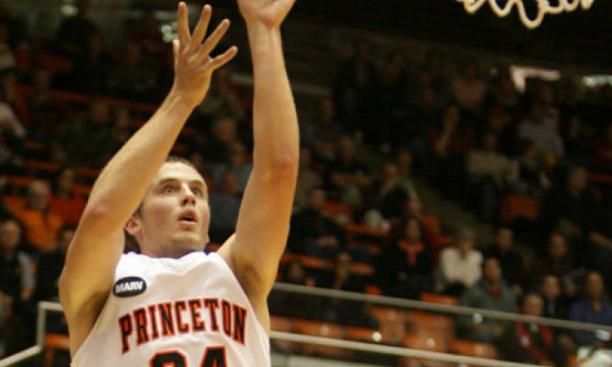
Through 10 games this season, PAW contributor Kevin Whitaker ’13 has compiled a list of 10 things to know about the 7-3 Princeton men’s basketball team. The first half is listed below. For part two, click here.

Sophomore Ian Hummer has played a key role in Princeton's more potent offensive attack. (© Beverly Schaefer)
1. Believe it or not, this team will run.
Quick: Name the most famous Princeton basketball victory and defeat in recent memory. Chances are you came up with this win and this loss. Now, take a look at those scores again: In both games, the two teams combined for fewer than 100 points. That is no coincidence – Princeton has been one of the nation’s slowest-paced teams for decades, and this trend has only grown in recent years. The Tigers were the nation’s slowest team (as measured by possessions per game) for three years in a row starting in 2004-05, and have been in the bottom 15 every season since at least 2002-03, the earliest for which possession data is available.
This year, head coach Sydney Johnson ’97 is letting Princeton run a little bit, a trend that even the Wall Street Journal picked up on earlier this week. Through 10 games, the Tigers have played at a pace of 65.5 possessions per 40 minutes; they averaged more than 60 only once in the previous eight seasons. Make no mistake, this is still not a fast-paced team – Princeton is slower than the national average – but the Tigers are no longer turtles.
2. Ian Hummer is really good.
As a freshman, Ian Hummer ’13 backed up Pawel Buczak ’10 and Zach Finley ’10 in the front court and showed promise off the bench. Many prognosticators expected Hummer to break out in his sophomore campaign, but the forward has surpassed even the loftiest of expectations. His 15.5 points per game lead the Tigers, while his 6.7 rebounds per game are tied for the team high. More impressive has been Hummer’s efficiency: He makes 62 percent of his field goals, best on the team, and has committed just 18 turnovers in 10 games.
The Hummer name is a familiar one to the Princeton basketball program – Ian’s father, Ed ’67, ranks tenth in program history with 550 career rebounds, while uncle John ’70 ranks seventh in scoring with 15.4 points per game. The second-generation Hummer, who was named the Ivy Player of the Week Dec. 6, is on the short list of conference Player of the Year candidates at this point in the season, along with Harvard’s Keith Wright, Penn’s Zack Rosen, and Yale’s Austin Morgan.
At the beginning of the year, if someone told you that a Tiger would have two 30-point outbursts in the first 10 games, who would you have guessed it was? If you said Kareem Maddox ’11, then you’re a liar. The forward showed some promise in limited playing time in his first three years, but contributed mostly on the defensive end, racking up blocks and rebounds. This season, the co-captain has made 56 percent of his attempts from the floor and averages 12 points per game. Nominally a reserve, Maddox starts the game on the bench but spends very little time there; he averages more than 30 minutes per game and is always on the floor in crunch time.
As the game goes longer, Maddox seems to play even better – he scored 30 points in an overtime victory over Siena and dropped 31 in a double-overtime win at Tulsa earlier this week, throwing down several thunderous dunks in each. The 6-foot-8-inch forward attempted only 13 shots from the floor in each game, producing a remarkably efficient line, and has cut down on miscues after an ugly seven-turnover game at Duke. But Maddox’s best asset is his ability to draw fouls and make free throws. He ranks in the top 100 nationally in free throw rate (free-throw attempts divided by field-goal attempts), and has made 77 percent of his foul shots at Princeton – a very good mark for a big man, especially one who is not a particularly strong jump shooter.
4. No lead is safe.
Several times already this season, games that appeared to be easy Princeton victories turned into nail-biters. In the season opener, Rutgers overcame a 14-point deficit to force overtime, and a week later Bucknell cut a 13-point margin to one possession. Monmouth trailed by 15 but had a shot in the air to tie the game in the final seconds, and even St. Joseph’s, down by 25 in the first half, eventually closed within single digits.
The Tigers won all those games, but were not so lucky at James Madison last month: They led JMU by as many as 20 points, but allowed the hosts to reel off a 16-0 run after halftime and retake the lead. Princeton would lose, 65-64, on two late free throws.
5. Princeton already has quality wins.
The Tigers have defeated some tough opponents already this season: a season-opening victory over intrastate rival Rutgers; a defeat of Siena (which has three NCAA tourney appearances in as many years, and two postseason victories); and a win at Tulsa, which is expected to contend for the Conference USA championship. All three games went to overtime. Rutgers and Tulsa were ranked in the top 100 nationally by stat guru Ken Pomeroy as of Monday (albeit barely). The last time Princeton has defeated a team that finished the year in the top 100 was a season-ending win over Penn in 2005-06; coincidentally, that game also went to overtime.

